More than 53% of marketers spend more than half of their marketing budget on lead generation because it’s an effective acquisition strategy.
In this post, we’ll share everything you need to know about generating high-quality leads.
From the strategies to tools, keep reading to find out more.
What is lead generation?
Before you get paying clients, you’ll need to go through a process to find your leads. This process is lead generation.
With lead generation, you identify, attract, and capture leads or potential clients.
This process is intricate and has many aspects you’ll need to take care of to ensure your lead generation is cost-effective and you get the maximum ROI possible.
Lead generation consists of 4 key elements:
- Attract attention
A key element in lead generation is making yourself (or your business) stand out. You’ll need to reel your leads in by setting up your profiles and attracting the attention of people who can be interested in your product or service.
We’ll tell you how further in this article.
- Qualify leads
Leads are hiding in plain sight, but you can’t just consider every contact a lead.
Your lead generation process consists of attracting qualified leads, so going through a lead qualification strategy is vital.
This will help you decide if your leads are worth it and how much nurturing they’re going to need.
- Capture information
Once you know who your leads are, you’ll need to contact them.
For your lead generation process to be successful, you need to be able to find your leads’ current and relevant data. Such as emails and phone numbers.
Once you have their contact info, you can move on to the last key element in your lead-generation process.
- Engage prospects
Lead generation also involves engagement with your leads. You can take 2 different approaches: inbound and outbound.
With inbound lead-gen, you’ll let them come to you, and with an outbound strategy, you’ll be contacting them directly.
Why is lead generation important?
Being the first step in customer acquisition, lead generation is the process of identifying your potential customers and contacting them so they become aware of your product or service.
At this stage, your goal is primarily focused on getting a means to communicate with them and further convert them in the process.
There are many reasons businesses prioritize lead generation and some of them include:
- Increased brand awareness
Lead generation strategies allow you to promote your business to a wider audience. This increases your reach and gives your company more visibility and brand recognition. Over time, it will lead to… 👇
- Higher sales records and revenue
Every single customer was once a lead.
The way you nurture them is what encourages them to do business with you. So generating more leads increases your chances of getting more customers and in turn, higher revenue.
- Better conversions
With lead generation, you can directly track the ROI of your marketing and sales efforts.
For example, you can track how many people are interested in your business based on how many website visits you get.
You can make more impactful decisions and know what works versus what doesn’t based on the patterns you get from your data.
- Cleaner data and customer insights
When you generate leads, you also get behavioral insights like their preferences and needs.
This can help with more precise targeting and personalizations that can positively influence your engagement. However, this works especially when you get your leads the right way.
Types of leads
A lead is anyone interested in your products and services.
Usually, when they become a lead, it means you have their contact information and some details about them. For example, their name, job title, and company, to mention a few.
You can categorize your leads in several ways:
Based on qualification
You can classify your leads based on their qualifications, which also relies on the funnel stage or the department that will be dealing with them.
This includes:
- Marketing qualified leads
These leads have usually shown interest in your business but passively.
For example, leaving an email address after downloading a resource. This makes them a great target for your marketing campaigns.
- Sales qualified leads
Here, the lead is very interested in your product, and they just need convincing from your sales team.
This could be someone who has signed up for a personalized demo or a chat with your team.
- Product qualified leads
Very similar to SQLs, but the difference is that here, the lead is already attached to your product.
Usually, they’ve already signed up for a free trial or are on the free plan and are looking for the right plan to suit their needs.
Based on the funnel stage
The sales funnel has three points: bottom, middle, and top of the funnel. You can classify your leads according to the point of the funnel in which they stand.
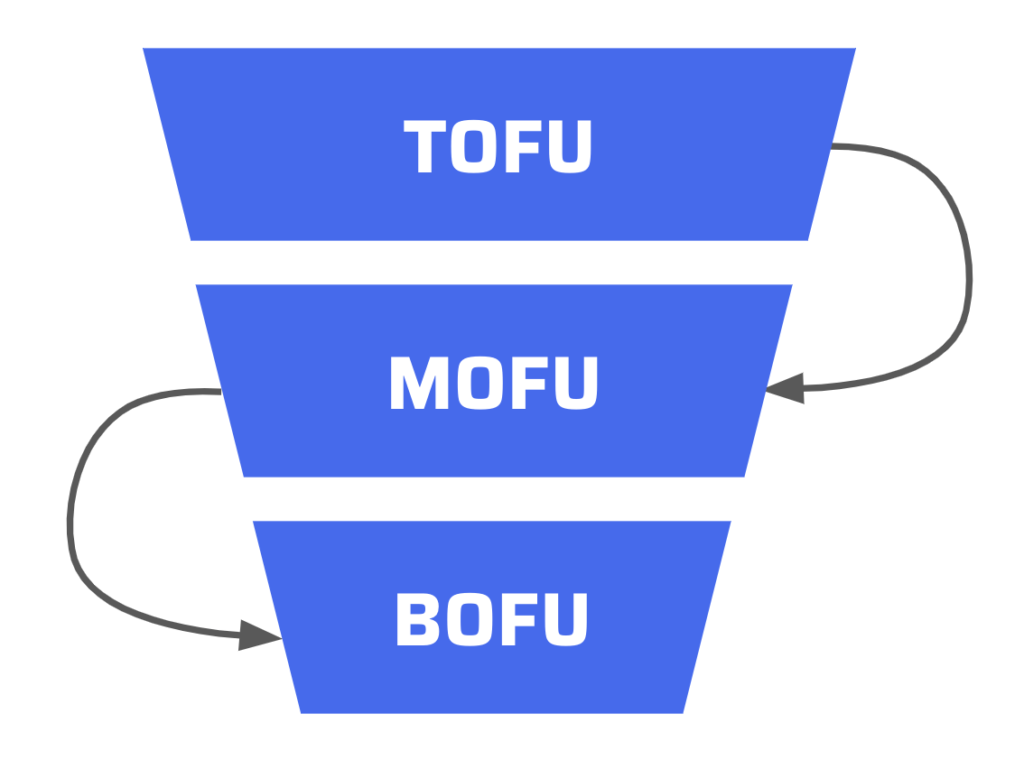
- Cold leads
These leads are located at the top of the funnel. Meaning they may be completely unfamiliar with your business.
This type of lead requires much more nurturing and a carefully planned out cold outreach strategy.
- Warm leads
Warm leads have heard of you and you know they have some sort of interest in your business. Perhaps they follow you on LinkedIn and have engaged with some of your posts.
Additionally, warm leads will typically have a need for your solution, which will make them much more receptive to hearing from you when you start your warm outreach strategy.
- Hot leads
These are our favorites.
Hot leads are located at the bottom of the funnel, meaning they are ready to buy from you.
Based on interests
This classification allows you to group your leads based on their level of interest, and how they also found your business.
- Inbound leads
leads who did their research and found your business themselves. An example might be someone who signed up for a product demo or your newsletter.
Irrespective of the types of classification, the basics remain the same. Inbound leads are very interested in your business and are known as warm leads.
Inbound leads could also be product-qualified leads and marketing-qualified leads.
- Outbound leads
Leads generated by you through either a lead generation tool or your marketing strategies. An example is the connections you sent messages to on LinkedIn.
Outbound leads are cold and usually passive. These could also be sales-qualified leads and sometimes marketing-qualified leads as well.
Lead generation methods
Depending on the type of lead you want to attract, there are two approaches to lead generation.
Don’t forget that the best approach is a combination of both methods!
1. Inbound lead generation
Inbound lead generation consists essentially of bringing leads to you instead of contacting them directly.
In other words, you’ll have to establish yourself as an industry leader by giving potential leads free resources, using SEO to increase your organic traffic, or setting up a LinkedIn strategy.
89% of B2B marketers rely on LinkedIn for lead generation, so setting up your strategy correctly is crucial.
2. Outbound lead generation
The outbound lead generation method uses a higher level of targeting and personalization from the sales and marketing teams. With this method, you’re taking complete charge of your lead acquisition.
82% of buyers accept meetings with sales reps who reach out to them.
This means that with a well-thought-out cold-emailing strategy, you could generate leads and convert them.
Other outbound strategies include:
- Paid ads
- Cold calling
- LinkedIn messaging
Lead generation tools
Lead generation tools, popularly known as lead generators, are tools that help teams automate the lead generation process.
They can be used to carry out both outbound and inbound lead generation at a larger scale.
When choosing a tool, make sure that it offers as many features as possible in order to avoid having to jump between different tools.
Some of these features include:
Email finders allow you to extract leads’ contact information easily and quickly.
lemlist’s free Email finder will find +80% verified emails for you. You can use it for single or bulk searches.
LinkedIn has proved to be a pool of leads with +1 billion users.
Therefore, you must have access to a Chrome extension that will allow you to extract contact information with just one click.
lemlist offers a Chrome extension that allows you to extract emails and phone numbers, with lead enrichment and the ability to push leads directly to your campaign without leaving the app.
And yes, it is available for free, too.

- Lead databases
When you invest in a lead generation tool, make sure it has a built-in lead generation database with verified and valid data.
lemlist has at your disposal +450M people and a 63M company database with advanced filters that will help you narrow down your list of leads to your ICP.
Among its advanced filters, you can find Signals & Intent to help you reach your leads at the perfect time. Some intent filters concerning companies include:
- Growth in the last 3 months
- Current company technologies
- Las funding dates
- Company revenue
- Keywords
- Email marketing and outreach tools
In order to conduct your full outbound lead generation strategy, you’ll need to have a tool to help you send your cold emails or multichannel sequences.
This is a very time-consuming process that requires a high-level personalization for it to fully work.
With lemlist, you can use AI to generate full sequences in seconds. You can give the cold email generator a go and see what we’re talking about.
- Calendar and call scheduling tools
Booking meetings is the goal in lead generation, so investing in a tool that offers a customizable booking page that integrates with all of your calendars is a must.
If you wonder what the average lead generation cost is, read our guide to learn everything about prices and how to save.
7 strategies to get high-quality leads (+ Examples)
If you’re not sure where to begin when building your sales generation strategy, here are a few examples to inspire you.
1. Set up a tripwire funnel for PPC Campaigns
This strategy uses a lead magnet to reel in cold leads at first and then triggers a paid product at the backend. It offers an inexpensive product to the customer to sell a more expensive one later.
For example, a lead might not be ready to purchase your course online just yet, so you create a cheaper mini-course as the tripwire and then a free ebook as the bait to reel them in.
Once they are locked into your eBook, you can upsell the mini-course which they’ll be more inclined to purchase.
Another example could be offering a 15-minute consultation service.
Tripwire funnels work because people like to have a good deal. However, they won’t easily commit to your business without a little nudge.
The sales from your tripwire would also help you offset any advertising costs spent.
Tips for setting up your Tripwire PPC campaign
- Identify your best-performing product or service and create an MVP that’s cheaper but highly valuable
- Run a highly targeted PPC campaign towards your target audience or demographic
- Set up marketing automation afterward based on their behavior and interaction with the product
2. Organize webinars
Webinars are a great way to attract warm leads. For one, they establish your business as a thought leader in your industry.
During this webinar, you can position your business while addressing any concerns they might have with your product or service.
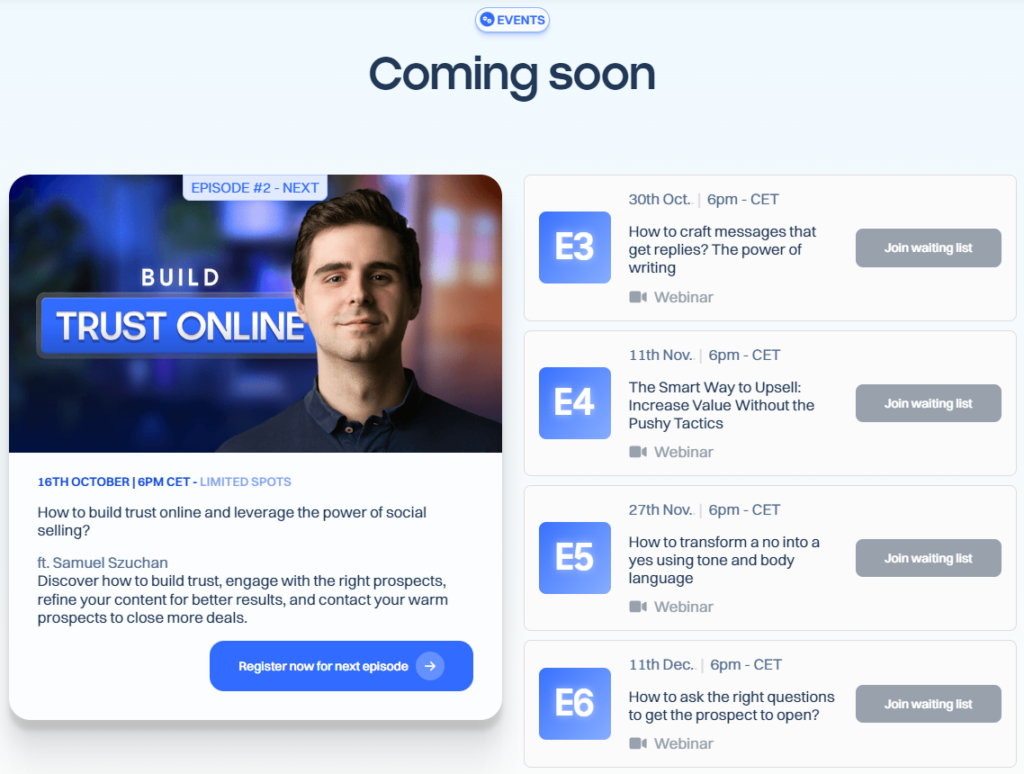
However, don’t do this the generic way!
Some strategies we recommend when using a webinar to generate leads include:
- Create a webinar topic to target a specific problem or point your prospect might have
- Add an open-loop system that leaves them curious. For example, sharing that your approach would be easy and free would make them even more expectant
- Keep on-demand downloads in exchange for contact information, like Slack
- In the webinar, use an attendee’s business to show a real-life example of how they can use your product or service to solve a problem
3. Offer helpful resources
Content marketing drives 3x more leads than any traditional marketing form.
That’s why you need to implement a content upgrade strategy to generate leads for your business. So don’t just stop at adding an email capture form at the end of your post, add an upgrade to it.
For example, if your blog post is about a personality type, a great upgrade would be a link to a personality quiz.
See how this business uses a cheat sheet on its podcast service page.
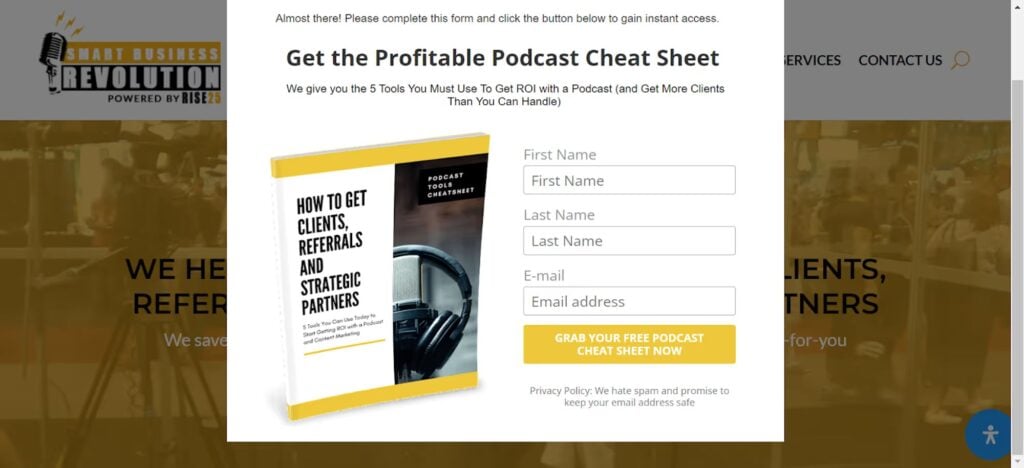
How can you build your resources?
- Create an upgrade they can’t get anywhere else – let them be eager to try it out
- Don’t use irrelevant content you worked on in the past – let the upgrade be highly relevant to the initial content
- Follow up with your subscribers on that particular topic – create a separate segment and target them until they convert
4. Be active on LinkedIn
As we mentioned earlier, LinkedIn is a great place to find cold leads, especially for sales teams.
This is because you can find decision-makers who would purchase your product or service.
So, in addition to building your company page and your sales team’s LinkedIn, here are a few strategies we recommend when generating leads on LinkedIn
- Take advantage of your connections – sending messages to your existing connections is way less spammy than calls. So review your connections to see if you have a lead in there
- Explore various inMail formats and lead generation forms – Use the data to improve your ad targeting
- Join groups and post frequently – that way you can learn more about your audience and use the knowledge to improve your lead-generation strategy
5. Give a personalized product demo
An effective product demo shows your value proposition and how it solves a user’s need at a given period.
This strategy is a way to reel in warm leads who have concerns they want to address.
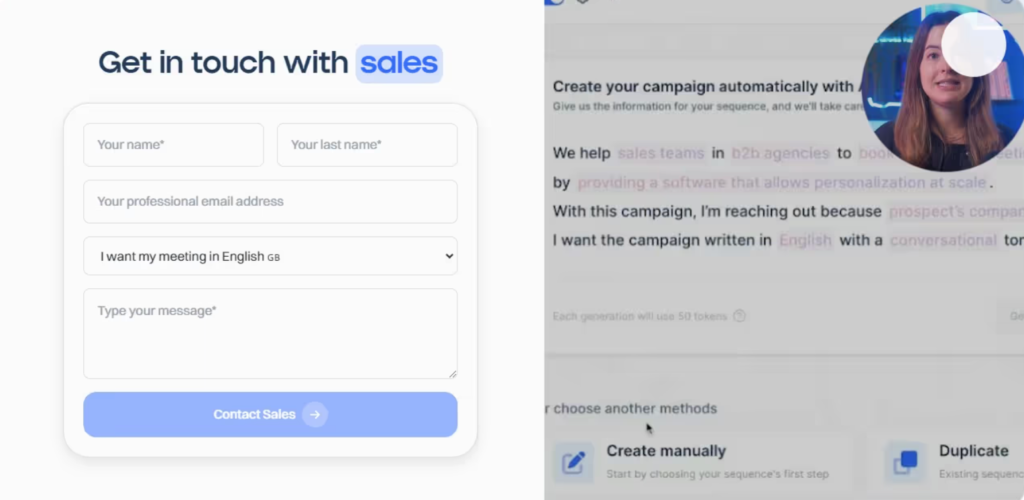
How can you set up your product demo strategy?
- Ask them what they expect on your demo request form – this gives you ample time to come up with solutions targeted to their needs
- Make it interactive – some prospects prefer a self-service option. In that case, be prepared to guide them through it
- Actively gather feedback during and after the demo to improve the experience for other prospects
- Follow up after the demo – remember, your end goal is conversion
6. Set up your cold email sequences
53% of marketers agree that emails are still the most effective lead-generation strategy, but that implies that the average prospect gets a lot of cold mail every day.
So before setting up a long sequence that’ll end up getting ignored, here’s how to keep your cold emails simple and to the point:
- Add social proof to verify your authenticity – this could be a link to your LinkedIn or company website
- Include specifics – don’t just say you were looking through their profile. That already sounds like a template. What did you see in their profile?
- Reference their pain point – what are you going to do for them? Why will it be worth their time?
- Keep it under 120 words – they’ll close the email if it’s any longer than that
- Create an automated sequence to follow up and engage with a multichannel approach
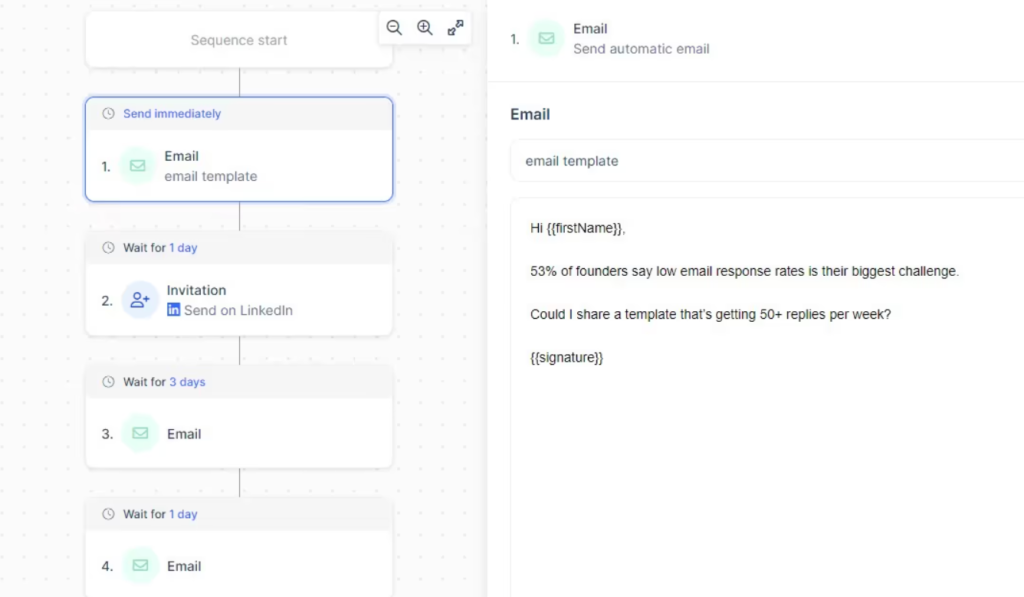
You can access a plethora of templates directly from your lemlist dashboard.
With the new template library, you will be able to duplicate more than entire campaigns. You’ll be able to take inspiration from cold emailing experts (and share your own), but you’ll also be able to save individual emails or use templates for images, landing pages, and sending schedules!
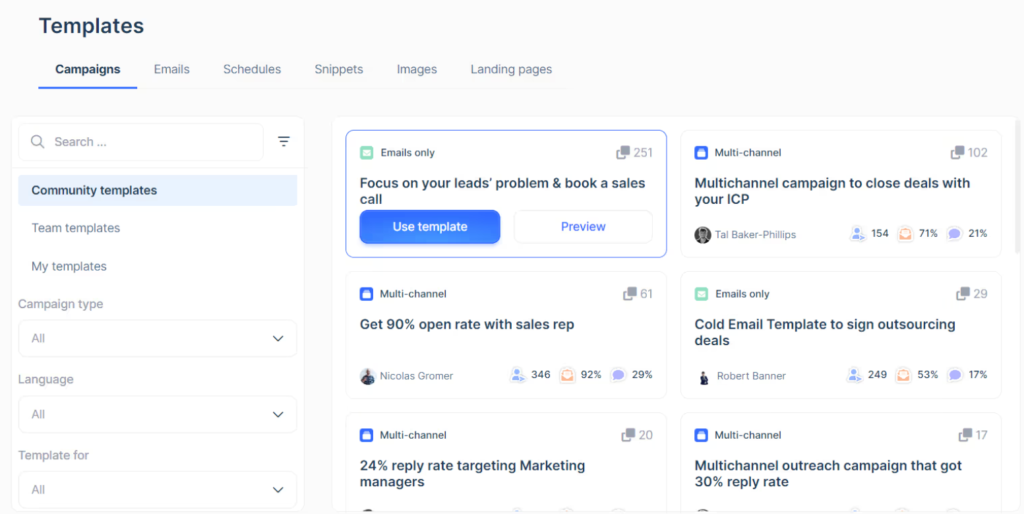
7. Avoid being pushy and sales-y at first
Cold calling still works.
However, your first call shouldn’t immediately be pushing for a sale because that seems spammy.
Instead, focus on proffering solutions to their problems for free.
Like a tripwire, you can nudge them to build a relationship with you, then try out your product or service to see if they think it helps.
So a script could be something like, “I know you already use your (current tool), but why don’t you play around with (my product) for a few days and see if it is something you might like later on?’
8. Use LinkedIn to Generate your Leads
If you’re not doing LinkedIn lead generation, you’re missing out big time.
LinkedIn currently has over 1 billion users, making it one of the largest databases you can find.
Although not every user will be a lead (obviously), LinkedIn offers advanced filters to help you narrow your list.
9. Implement AI
AI lead generation comes with many benefits, including:
- Increased efficiency
- Save time and money
- Enhanced data analysis
- Fewer mistakes and missed opportunities
- High-level personalization in all your outreach
- Receive detailed insights into your leads and sales process
Using AI in your lead generation can help you to
- identify your buyer persona,
- find leads,
- segment and qualify leads,
- personalize messages,
- track your lead status and more.
Invest in the most comprehensive lead-generation tool
Lead generation is a lot of work, especially on a large scale, so you need a system that helps you find and nurture these leads.
Fortunately, tools now help you source contact information, verify that these details are correct, reach out to these prospects, and nurture them until they finally convert.
However, rather than subscribing to multiple tools that can achieve this, we recommend using an all-in-one tool to save big on your sales budget.
With lemlist, you can find leads and reach out to them on multiple platforms like emails, calls, and LinkedIn.
Start your lemlist free trial now and check out how it can help you.
Starting a lead generation business: is it a good idea?
Starting a lead generation business has a low barrier to entry. That means there’s a lot of competition.
But to start a lead generation business, you need to be able to find, well… leads!
There are several methods to generate leads, such as cold emails, lead databases, LinkedIn leads, cold calls, SEO, and more.
In fact, we wrote this comprehensive guide on how to start lead generation business so you will know what to expect.
Essentially, starting your own lead generation business starts from the same point as any lead generation.
To set yourself apart from the competitors, you have to find high-quality leads quickly.
Your source of actionable outreach tips and strategies that will help you get replies and grow your business.

